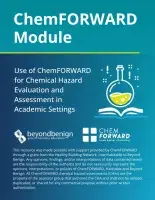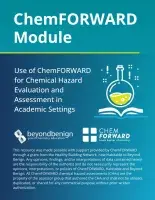- "Students are given the opportunity to assess chemical products and processes and design greener alternatives when appropriate."
- "Students understand and can evaluate the environmental, social, and health impacts of a chemical product over the life cycle of the product, from synthesis to disposal."
At the highest level of the ACS guidelines, students are expected to have a deeper understanding of and critical thinking skills around developing and designing greener chemical products and processes. This can include the various environmental, social and health aspects of a chemical product, in particular as it pertains to life cycle analysis.
GCTLC Library
Below are resources from the GCTLC library that are tagged with any of the following Green Chemistry Principles:
- #3 (Less Hazardous Chemical Syntheses)
- #4 (Design Safer Chemicals)
- #5 (Safer Solvents and Auxiliaries)
OR have been tagged with keyword "Life Cycle Assessment".
The variety of resources below should provide educators with numerous options to help tailor their lectures and courses with more green and sustainable chemistry content. However, if you have additional suggestions for resources, you can always submit them for inclusion in the GCTLC library, or you can post them in the forum "Green Chemistry Resources for Addressing the ACS Guidelines" on the GCTLC.

CHEM21 selection guide of classical- and less classical-solvents
This article provides a ranking of and selection guide for both classical and less classical solvents, based on existing solvent selection guides as well as a set of proposed criteria on Health, Safety and Environment aligned with the Global Harmonized System (GHS) and European regulations. More details are available in the linked article.
Full citation: Prat, D.; Wells, A.; Hayler, J.; Sneddon ...

ChemFORWARD Module Overview
The ChemFORWARD module aims to help instructors teach students how to use the ChemFORWARD platform to obtain hazard information for specific chemicals, and to identify safer chemicals to replace chemicals of concern in research and in product formulations.
The module is organized into two units. Each unit contains a unit overview, specific learning outcomes, course alignment, prerequisites ...

ChemFORWARD Module Unit 1: Introduction to ChemFORWARD, and Use of ChemFORWARD to Find Safer Chemical Alternatives
This unit provides details on the organization and use of the ChemFORWARD platform, the information that can be obtained using the platform, and how to use the platform to find safer chemical alternatives for chemicals of concern. Details are provided in the ChemFORWARD How-To Guide. Pertinent slides with screenshots are provided. Students can be directed to the diethyl phthalate example ...

ChemFORWARD Module Unit 2: Avoiding Regrettable Substitutions, Natural Is Not Always Safer
This unit reiterates the importance of avoiding regrettable substitutions, emphasizes the importance of data gaps, and also cautions that naturally-occurring chemicals are not always safer, regardless of the many claims made in some consumer products.
This module unit was reviewed by Julian Silverman (Ph.D.) and Sarah Prescott (Ph.D.).
The inspiration of this work began with a Forsythia ...

Cinnamon Oil: An Alternate and Inexpensive Resource for Green Chemistry Experiments in Organic Chemistry Laboratory
We report a series of experiments based upon cinnamon oil that were developed to provide a practical integration of green and sustainable chemistry concepts for the organic chemistry laboratory. Five experiments centering around cinnamaldehyde as a green, plant-based chemical were performed by undergraduate students in a second-year organic chemistry class. Cinnamon oil was obtained through ...

Cocrystal Controlled Solid-State Synthesis. A Green Chemistry Experiment for Undergraduate Organic Chemistry
In this set of experiments, students will be introduced to condensation reactions, green chemistry, and cocrystal-controlled solid-state synthesis. This type of solid-state synthesis is performed by first making cocrystals of the two reactants (in this case an anhydride and an amine) which brings the reactive functional groups in close proximity to one another, allowing for a reaction to occur ...

Comparative Methylation of 1,8-Dihydroxy-9,10-anthraquinone: Chemoselectivity in the Organic Chemistry Laboratory
This experiment demonstrates chemoselectivity in various reaction conditions. The mono or di-methylation of 1,8-dihydroxy-9,10-anthraquinone can be controlled by either refluxing the reagents in tetraglyme or by simply heating without solvent. Also, this ether synthesis has been made greener by eliminating flammable THF and dangerous sodium hydride and by using a less toxic methylating agent. ...

Designing 3 experiments from Vinegar and an Antacid
In this activity, students explore how much Carbon Dioxide is produced from varying combinations of reactants. Students use stoichiometric calculations to determine the theoretical anticipated amount of CO2. Students record observations and measurements of mass of reactants before and after the reaction. Students use the recorded measurements to calculate the amount of Carbon Dioxide produced.In ...

Determination of the Formula of a Hydrate: A Greener Alternative
The determination of the formula of a hydrate is an experiment that introduces students to many fundamental chemical concepts including stoichiometry, the notion of a mole, and nomenclature. In this experiment, the authors replaced the previously used calcium and barium salts because the latter is considered poisonous and tumorigenic, and both were considered waste after only one use. Instead ...

Determination of the Heat of Combustion of Biodiesel Using Bomb Calorimetry. A Multidisciplinary Undergraduate Chemistry Experiment
This lab teaches important basic chemistry skills in the context of utilizing renewable feedstocks. In a three-week series of experiments, students will synthesize biodiesel from peanut oil and determine the heat of combustion, density, and cloud point of their product. Students will then use this information to evaluate the viability of biodiesel when compared to petroleum diesel.
Physical ...
Pagination
- Previous page
- Page 5
- Next page